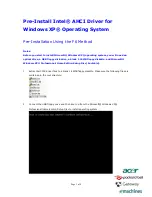Summary of Contents for J4813A
Page 1: ...ProCurve Identity Driven Manager User s Guide Software Release 2 0 ...
Page 20: ...1 16 About ProCurve Identity Driven Manager ProCurve Support ...
Page 69: ...3 15 Using Identity Driven Manager Configuring Times ...
Page 124: ...3 70 Using Identity Driven Manager Using the User Import Wizard ...
Page 140: ...A 6 IDM Technical Reference Types of User Events This page is intentionally unused ...
Page 144: ......



































